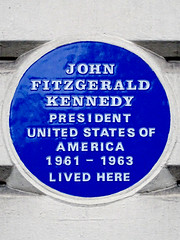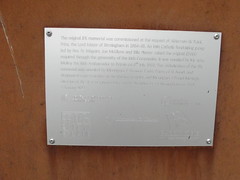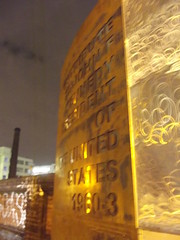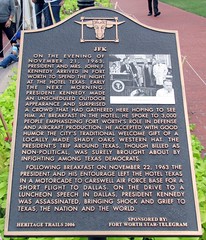John Fitzgerald Kennedy


John Fitzgerald Kennedy
(1917-1963)
35th President of the United States (1961-1963)
Commemorated on 8 plaques
John Fitzgerald Kennedy, President United States of America 1961-1963 lived here
14 Prince's Gate, Westminster, London, United Kingdom where they lived
Birthplace of Patrick Kennedy, great grandfather of President John F. Kennedy, U.S.A., who returned to his ancestral home on 27th June, 1963.
Dunganstown (right off the R733 travelling south from New Ross), New Ross, Ireland where they visited (1963)
John F. Kennedy President of the United States stood here when he delivered his address on the interdependence of nations July 4th 1962
Independence Hall, Chestnut Street, Philadelphia, PA, United States where they stood (1962)
Built in 1890 as quarters for navy officers, the Little White House later was used by American Presidents William Howard Taft, Harry S. Truman, Dwight Eisenhower, John F. Kennedy, Jimmy Carter and Bill Clinton. Truman used the facility as a vacation home and functioning White House between 1946 and 1952....
111 Front St, Key West, FL, United States where they was
The original JFK memorial was commissioned at the request of Alderman Sir Frank Price, the Lord Mayor of Birmingham in 1964-65. An Irish Catholic fundraising group led by Rev. Fr. Maguire, Joe McGlynn and Billy Hestor raised the original £5000 required through the generosity of the Irish Community. It was unveiled by Mr John Mclloy the Irish Ambassador to Britain on 8th July 1968. The rededication of the JFK memorial was unveiled by Monsignor P. Browne Parish Priest of St. Anne's and designated representative of Archbishop Longley and Monsignor J. Daniel McHugh Director of the Regeneration of the Archdiocese of Birmingham 23rd February 2013.
JFK Memorial - High Street Deritend, Digbeth, Birmingham, United Kingdom where they is commemorated
In tribute to John F Kennedy President of the United States 1960-3 A man may die nations may rise and fall but an idea lives on
JFK Memorial - Floodgate Street / High Street Deritend, Digbeth, Birmingham, United Kingdom where they is commemorated (2013)
Texas Historical Marker #17005
Rice University. William Marsh Rice (1816-1900) came to Texas in 1838 and through extensive entrepreneurship became one of the state's wealthiest men. Rice envisioned a polytechnic school as his philanthropic legacy. The State of Texas chartered the William M. Rice Institute for the Advancement of Literature, Science and Art on May 19, 1891. Rice delayed the project by stipulating that it open after his death. When he died under suspicious circumstances, investigations and legal struggles jeopardized the school's future. After his estate was settled, development began for the first university in Houston. Trustees had a multi-million dollar endowment but little experience in education. The first president, Dr. Edgar Odell Lovett of Princeton University, spent months visiting experts around the world. His experiences helped him broaden Rice's vision to a university uniting teaching and research. In 1909, the Boston firm of Cram, Goodhue and Ferguson developed the campus plan, combining classically-inspired architecture with Mediterranean influences. On Sep. 23, 1912, classes opened with 59 young men and women and four buildings. Rice was a charter athletic member of the Southwest Conference (1914) and quickly achieved academic accreditation, with the first class graduating in 1916. Two world wars and the Great Depression slowed growth. In 1945, trustees broadened the curriculum and initiated a substantial building program. Renamed Rice University in 1960, the school has hosted presidential visits, including John F. Kennedy's in 1962 when he urged the nation's space program to explore the moon by the end of the decade. Rice boasts many distinguished alumni and faculty, including Nobel and Pulitzer Prize recipients. In 2012 Rice University embarked on its second century of producing "leaders across the spectrum of human endeavor." 175 Years of Texas Independence * 1836-2011 #17005
?, Houston, TX, United States where they visited (1962)
JFK On the evening of November 21, 1963, President and Mrs. John F. Kennedy arrived in Fort Worth to spend the night at the Hotel Texas. Early the next morning, President Kennedy made an unscheduled outdoor appearance and surprised a crowd that had gathered here hoping to see him. At breakfast in the hotel, he spoke to 3,000 people emphasizing Fort Worth’s role in defense and aircraft production. He accepted with good humor the city’s traditional welcome gift of a locally made Shady Oaks Western Hat. The president’s trip around Texas, though billed as non-political, was surely brought about by infighting among Texas democrats. Following breakfast on November 22, 1963 the president and his entourage left the Hotel Texas in a motorcade to Carswell Air Force Base for a short flight to Dallas. On the drive to a luncheon speech in Dallas, President Kennedy was assassinated, bringing shock and grief to Texas, the nation and the world.
999 Main St, Fort Worth, TX, United States where they was






